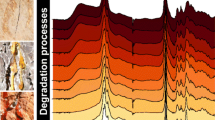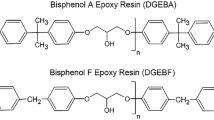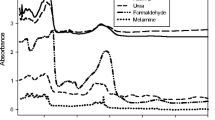Abstract
The traditional analytical methods used to determine phenolic resin are slow and produce environmentally unfriendly waste. In this work, Near-infrared (NIR) spectroscopy has been applied for resin content of phenolic resins. The partial least square regression was used to develop the calibration model of the resin content. 8 samples were withdrawn at different time stages for analysis with the proposed quantitative models; the data thus obtained were compared with those provided by reference methods. The maximal predicted error and the standard deviation of the differences were 0.96 and 0.51% for resin content. The results of the paired t-test revealed that there was no significant difference between the NIR method and the reference method. NIR spectroscopy is an effective choice for the accurate, expeditious analyzing quality of phenolic resin.
Similar content being viewed by others
References
Reghunadhan, N.P., Advances in Addition-Cure Phenolic Resins, Prog. Polym. Sci., 2004, no. 29, pp. 404–410.
Mohamed, O., Abdalla, A.L., and Temisha, M., Boron-Modified Phenolic Resins for High Performance Applications, Polymer, 2003, no. 44, pp. 7353–7359.
Maurus, B. and Koni, G. Phenolic Resins for Can Coatings: I. Phenol-Based Resole Analysed by GC-MS, GC-GC, NPLC-GC and SEC, LWT-Food. Sci. Techno, 2006, no. 39, pp. 633–646.
Sadhra, S., Gray, C.N., and Fouldsi, S., High-Performance Liquid Chromatography of Unmodifed Rosin and Its Applications in Contact Dermatology, J. Chromatography, 1997, no. 700, pp. 101–110.
Smith, P.A., Son, P.S., Callaghan, P.M., Jederberg, W.W., Uhlmann, K.K., and Still, K.R., Sampling and Analysis of Airborne Resin Acids and Solvent-Soluble Material Derived from Heated Colophony (Rosin) Flux: a Method to Quantify Exposure to Sensitizing Compounds Liberated During Electronics Soldering, Toxicology, 1996, no. 111, pp. 225–238.
Rodríguez-Guadarrama, L.A., Application of Online Near Infrared Spectroscopy to Study the Kinetics of Anionic Polymerization of Butadiene, Euro. Polym. J., 2007, no. 43, pp. 928–937.
Garrido, M., Larrechi, M.S., and Rius, F.X., Validation of the Concentration Profiles Obtained from the Near Infrared/Multivariate Curve Resolution Monitoring of Reactions of Epoxy Resins Using High Performance Liquid Chromatography As a Reference Method, Anal. Chimi. Acta, 2007, no. 585, pp. 277–285.
Blanco, M. and Villaescusa, V., Use of NIR Spectroscopy in the Production of Modified Industrial Resins, Talanta, 2007, no. 71, pp. 1333–1338.
Marengoa, E., Bobbaa, M., and Robotti, E., Hydroxyl and Acid Number Prediction in Polyester Resins by Near Infrared Spectroscopy and Artificial Neural Networks, Anal. Chim. Acta, 2004, no. 511, pp. 313–322.
Judge, M.D., The Application of Near-Infrared Spectroscopy for the Quality Control Analysis of Rocket Propellant Fuel Pre-Mixes, Talanta, 2004, no. 62, pp. 675–679.
Author information
Authors and Affiliations
Additional information
Original Russian Text © Y. Dong, S.Y. Qu, 2012, published in Defektoskopiya, 2012, Vol. 48, No. 1, pp. 109–113.
The article is published in the original.
Rights and permissions
About this article
Cite this article
Dong, Y., Qu, S.Y. Analysis of rapid method for the quality index of phenolic resins and benefit. Russ J Nondestruct Test 48, 69–73 (2012). https://doi.org/10.1134/S1061830912010044
Received:
Published:
Issue Date:
DOI: https://doi.org/10.1134/S1061830912010044




